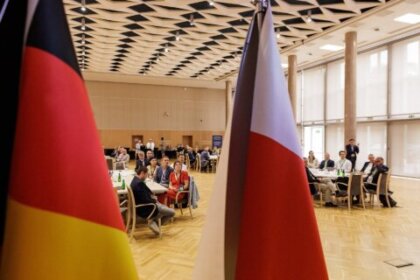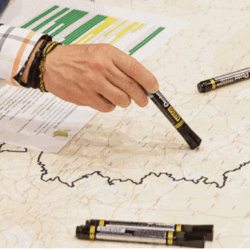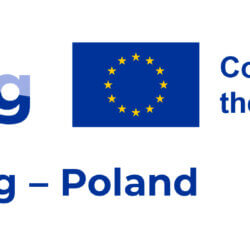


On Friday, 6 June 2025, the first German-Polish workshop of the project ‘BB-L Interconnection‘. Vision for a Joint Interaction Area took place in Zielona Góra. Around 50 representatives of local authorities, regional planning, public administration and academia from both sides of the river Oder accepted the invitation from the lead partner, the Marshal’s Office of the Lubuskie Voivodeship.
The project, which is being implemented by the Marshal’s Office of the Lubuskie Voivodeship in cooperation with the Joint Spatial Planning Department Berlin-Brandenburg and the Brandenburg University of Technology Cottbus-Senftenberg, aims to strengthen administrative cooperation and integration between East Brandenburg and the Lubuskie Voivodeship in the field of spatial and regional development. The Brandenburg-Lubuskie joint interaction area faces shared challenges for future spatial development that require coordinated, integrated action. The project will therefore first analyse opportunities and challenges as part of a territorial diagnosis of the Brandenburg-Lubuskie joint interaction area currently being developed by the agency Zespół Doradców Gospodarczych TOR based on cross-border statistical evaluations.
This territorial diagnosis provided the basis of the workshop in the Column Hall of the Marshal’s Office in Zielona Góra. After brief presentations of the interim results of the diagnosis, the participants discussed these results in mixed German-Polish groups. They exchanged their views on the demographic, spatial and socio-economic development of the joint interaction area and identified obstacles and prospects for future development.
The participants agreed that demographic change, in particular the ageing population, low birth rates and out-migration from peripheral regions, constitutes a major challenge on both sides of the border. At the same time, they emphasised that the larger urban centres and their surrounding areas are developing positively and that these growth impulses should also be carried over to the areas in between the centres. This requires better connections to the cities and an expansion of transport accessibility. It was also noted that the comparatively low property prices present a valuable opportunity to promote immigration and thereby stabilise the demographic situation. The existing education and training opportunities in the region were assessed positively, although closer links with the labour market and cross-border information and advisory structures would be needed to counteract outward migration more effectively.
 Bild: Katarzyna Klimkowska/Lubuskie.pl
Bild: Katarzyna Klimkowska/Lubuskie.plThe main obstacles identified were the small number of border crossings, existing border controls and infrastructure deficits, particularly in rail transport. The participants considered the expansion and electrification of railway lines, uniform fare systems and coordinated timetables to be priorities for action. Although progress has already been made in cross-border coordination through past and current projects, there is still a need for improved coordination of infrastructure development. The participants saw particular potential in direct rail links between eastern Brandenburg and Lubuskie and in the expansion of tourist cycle paths. The renewable energy sector also offers promising opportunities for the region, provided that targeted investment is made in storage technologies and high-performance transmission grids.
The economic development of the joint interaction area continues to be hampered by language barriers and legal and administrative hurdles. The border closures add an additional negative impact. The workshop emphasised the need for language courses and multilingual information services for employees and companies in order to better exploit cross-border economic potential. Additional potential for development was identified in the area of sustainable tourism.
Demographic change exacerbates the challenges facing public services, especially in rural areas. Increasing demands on healthcare and elderly care require innovative solutions. The shared use of social infrastructure on both sides of the border was discussed as a possible approach. In addition, better access to cultural offerings across the border can improve the quality of life in the joint interaction area.
The workshop made it clear that, despite the existing challenges, there is significant development potential in the East Brandenburg-Lubuskie joint interaction area. A particular emphasis was placed on the importance of cross-border cooperation and exchange between regional stakeholders. The results of the lively discussions will now be incorporated into the further project work and form an important basis for the development of a joint cross-border vision for the future of the Brandenburg-Lubuskie joint interaction area.
 Bild: Katarzyna Klimkowska/Lubuskie.pl
Bild: Katarzyna Klimkowska/Lubuskie.plThe territorial diagnosis discussed in the workshop is the first of four strategic documents to be developed as part of the BB-L Interconnection project. In addition, the topics of polycentric settlement structure and energy supply will be analysed in two in-depth expert reports. The findings from the territorial diagnosis, the results of these two expert reports and the feedback from a wide range of participants will then be incorporated into the development of a joint vision for the future of the Brandenburg-Lubuskie joint interaction area.
The project is funded by the European Union from the European Regional Development Fund (ERDF) as part of the INTERREG VI A Brandenburg-Poland 2021-2027 cooperation programme. It has a total budget of EUR 1.02 million.
 Bild: Interreg Brandenburg-Poland
Bild: Interreg Brandenburg-PolandThe staff of the European Spatial Development Unit at the Joint Spatial Planning Department Berlin-Brandenburg is responsible for the management and implementation of the project.